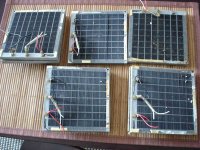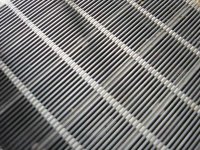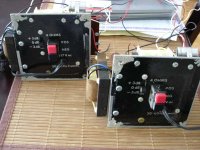so, a friend of mine had some JanZen ESL panels sitting in a box, and i figured i would take a look at them and see if they can do anything. i really don't know how to hook them up or what to do with them yet, maybe you guys can give me some ideas. i have a total of 8 of them, and two of the backplates.
here are some pics. they are in good shape, but have grill foam fuzz all over them. but overall, the diaphragms look good.
here are some pics. they are in good shape, but have grill foam fuzz all over them. but overall, the diaphragms look good.
Attachments
re; janszen electrostatic panels
These panels are wire wound stator versions from the mid to late 70's, and represent the last generation of the famous Janszen design. The sound of these panels typifies the effortless, extended and incredibly revealing highs for which electrostatic speakers are justifiably famous. From your photos, they look to be in pretty decent shape and will probably work fine when cleaned up a bit. I assure you, they are worth the effort.
First, using a soft brush and a vacuum, carefully remove as much of the loose debris as possible. Use caution to avoid forcing dirt through the stators or stretching the wires. After removing as much loose material as possible, gently wipe the stator wires with a lint free cloth slightly dampened with water. Make sure to only wipe with the direction of the stator windings, not across. If necessary, repeat the process with a cloth slightly dampened with technical grade alcohol. Do not wet the diaphragm.
The attached schematic is for the stand alone (model 130) tweeter array, so your step-up / bias supply may be a bit different from what is shown. Most were very similar, so you should still be OK. If you know the specific model from which the parts came, you might try searching the Audio Circuit for more information. You will probably need to replace the NP electrolytic capacitor (C-1) in the input circuit due to age. Also, the wire wound bias adjust pots (P-1) are known frequently go open.
The color codes for the wiring are as follows:
Red (+)
Black (–)
White (Bias - negative 1000- 1100 VDC)
When high voltage is first applied, the panels will make strange snapping and popping sounds. Don’t worry; they will eventually quiet down, even though it may take several days. If possible, I would recommend leaving the bias supply on all the time, in order to avoid such noises when first powered on.
In 1981, I was fortunate to have purchased a large quantity of new panels from an electronics surplus store in Minneapolis. Over the years, I have used them in a variety of applications, the latest of which employs ten panels per side in a line array, along with six (Monsoon) neodymium planar midranges, and a bass panel from the Magneplanar Tympani 1D. The results are very promising.
Regards,
Keith
These panels are wire wound stator versions from the mid to late 70's, and represent the last generation of the famous Janszen design. The sound of these panels typifies the effortless, extended and incredibly revealing highs for which electrostatic speakers are justifiably famous. From your photos, they look to be in pretty decent shape and will probably work fine when cleaned up a bit. I assure you, they are worth the effort.
First, using a soft brush and a vacuum, carefully remove as much of the loose debris as possible. Use caution to avoid forcing dirt through the stators or stretching the wires. After removing as much loose material as possible, gently wipe the stator wires with a lint free cloth slightly dampened with water. Make sure to only wipe with the direction of the stator windings, not across. If necessary, repeat the process with a cloth slightly dampened with technical grade alcohol. Do not wet the diaphragm.
The attached schematic is for the stand alone (model 130) tweeter array, so your step-up / bias supply may be a bit different from what is shown. Most were very similar, so you should still be OK. If you know the specific model from which the parts came, you might try searching the Audio Circuit for more information. You will probably need to replace the NP electrolytic capacitor (C-1) in the input circuit due to age. Also, the wire wound bias adjust pots (P-1) are known frequently go open.
The color codes for the wiring are as follows:
Red (+)
Black (–)
White (Bias - negative 1000- 1100 VDC)
When high voltage is first applied, the panels will make strange snapping and popping sounds. Don’t worry; they will eventually quiet down, even though it may take several days. If possible, I would recommend leaving the bias supply on all the time, in order to avoid such noises when first powered on.
In 1981, I was fortunate to have purchased a large quantity of new panels from an electronics surplus store in Minneapolis. Over the years, I have used them in a variety of applications, the latest of which employs ten panels per side in a line array, along with six (Monsoon) neodymium planar midranges, and a bass panel from the Magneplanar Tympani 1D. The results are very promising.
Regards,
Keith
Attachments
great. that information was everything i needed to play around with them.
i hear they can be quite good. do you have any information about crossing them over, frequency range, etc? im sure i could just listen to them, but i really don't know even how high or low they can go safely.
i hear they can be quite good. do you have any information about crossing them over, frequency range, etc? im sure i could just listen to them, but i really don't know even how high or low they can go safely.
The specs say 500 - 800Hz, but don't specify what slope.
I have used them in a ten panel array at those frequencies, but with only a few panels, that may be a bit optimistic. More likely 1000 - 1200Hz with reasonable slopes.
One other thing I forgot to mention is the bolts used to make the electrical contacts on the panels are almost always loose. Clean them up (or replace them with 4/40 brass), treat with contact enhancer of your choice, and tighten firmly. In my experience, this is the source of 95% of "failed" or intermittant panels, but since the bolts are usually covered by a label, the problem is not always immediately obvious.
Also, on every panel I have seen, the date of manufacture, along with the initials of the technician, are written in pencil on the front of the frame under the label.
Here's a link to some more info:
http://gallery.audioasylum.com/cgi/view.mpl?UserImages=17279
Good luck!
Keith
I have used them in a ten panel array at those frequencies, but with only a few panels, that may be a bit optimistic. More likely 1000 - 1200Hz with reasonable slopes.
One other thing I forgot to mention is the bolts used to make the electrical contacts on the panels are almost always loose. Clean them up (or replace them with 4/40 brass), treat with contact enhancer of your choice, and tighten firmly. In my experience, this is the source of 95% of "failed" or intermittant panels, but since the bolts are usually covered by a label, the problem is not always immediately obvious.
Also, on every panel I have seen, the date of manufacture, along with the initials of the technician, are written in pencil on the front of the frame under the label.
Here's a link to some more info:
http://gallery.audioasylum.com/cgi/view.mpl?UserImages=17279
Good luck!
Keith
yep, there is a date on there. 2-9-73. old little suckers.
does anyone have an idea what these are worth? im not sure i want to tackle yet another project... and im sure someone has some ideas for these. i really don't. when it comes down to it, i don't need another pair of speakers.
does anyone have an idea what these are worth? im not sure i want to tackle yet another project... and im sure someone has some ideas for these. i really don't. when it comes down to it, i don't need another pair of speakers.
- Status
- Not open for further replies.
- Home
- Loudspeakers
- Planars & Exotics
- JanZen ESL panels


